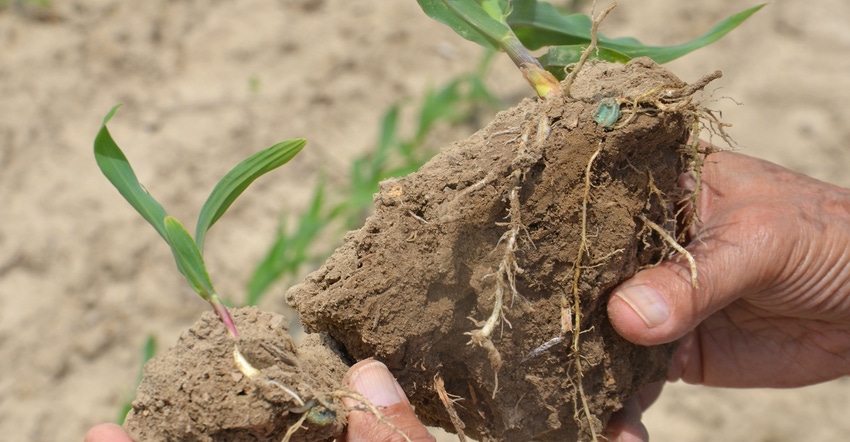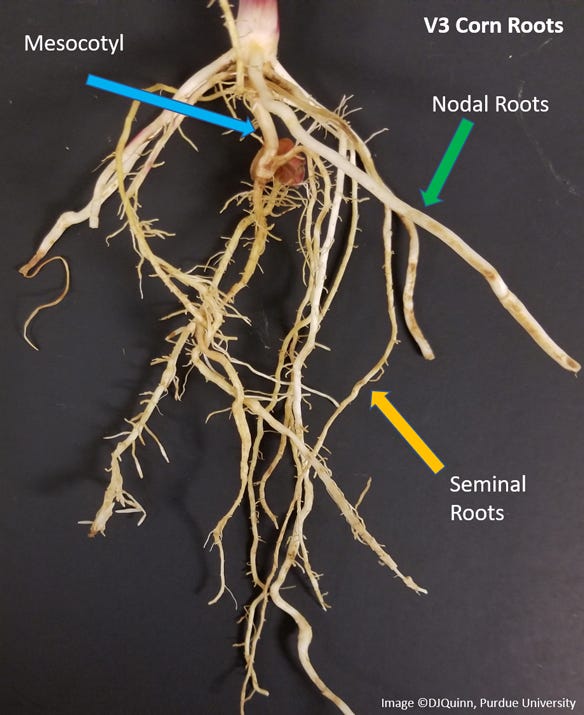April 28, 2022

As young corn plants begin growing, you may ask why your corn looks stunted, pale green and/or “crappy.” One of the first places to look is below ground. Dig up some plants.
Just because seeds were planted into good conditions resulting in rapid and uniform emergence doesn’t mean successful stand establishment was achieved. Successful stand establishment is largely driven by successful initiation and transition of a corn plant’s reliance on the seminal root system to reliance on the nodal root system.
The seminal root system consists of the radicle, or first root to emerge, and lateral seminal roots, which emerge from the seed. This is the primary root system until about growth stage V3. A V3 plant has three corn leaves with visible collars. The seminal root system anchors the young corn plant and helps with some water and nutrient uptake. However, a young seedling primarily depends on energy and nutrition reserves within the seed for development.
Since young corn plants depend on seed reserves until establishment and transition to the nodal root system, damage to the seminal roots, seed and/or mesocotyl can result in stunting or death. The mesocotyl is the white tissue connecting the seed to the coleoptile base. Injury examples include salt damage due to high starter fertilizer rates, seedling disease and insect feeding.
Big shift
At V3, the corn plant begins shifting to reliance on the nodal root system instead of the seminal root system. The nodal root system first develops from above the mesocotyl and at the lowermost node of the corn plant. Nodal roots that eventually grow above ground are known as brace roots and help acquire water and nutrients from upper soil layers. They also help stabilize the plant during the growing season.
Poor conditions and stress to a corn plant during this transition can severely stunt and/or delay plant development, resulting in lost yield potential. Subsurface banded starter fertilizer, like a 2-by-2 placement, can help facilitate this transition. Seedlings benefit from close fertilizer placement and immediate access to nutrients by the emerging nodal root system.
If a young corn plant can’t successfully establish and transition to nodal roots due to stresses and poor nodal root growth, kernel reserves become depleted. There is no more energy for the plant, and significant harm can occur. Stress examples that can harm nodal root development include soil compaction, salt injury due to high starter fertilizer rates, seedling disease, excessively wet or dry conditions, and insect damage.

As young plants emerge, get into the field, look at their health, dig some up and assess root health. You don’t want to see roots that are stunted, dead and/or containing brown or black discoloration. However, these symptoms may help you understand why young corn plants do not look good.
Overall, getting a corn plant off to a good start and achieving successful emergence and stand establishment is critical. It ensures greater stress tolerance throughout the season, setting the stage for high corn yields.
Quinn is a Purdue Extension corn specialist. Email [email protected] or call 765-494-5314.
You May Also Like




